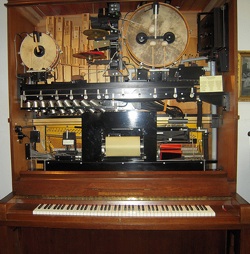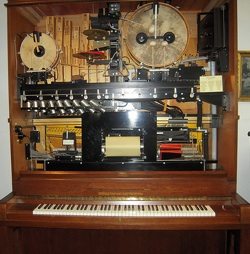Note: this post originally appeared on musiclessons4youonline.com in March 2010.
 It may sound like a contradiction, but if you want to create music when you play you must be able to hear the music first – in your head. This goes doubly if you want to improvise, compose or play by ear!
It may sound like a contradiction, but if you want to create music when you play you must be able to hear the music first – in your head. This goes doubly if you want to improvise, compose or play by ear!
Ever noticed how great jazz improvisors often sing along with their own solo?
Or how rock guitarists’ mouths move as if they’re singing out each note they play?
These players know exactly what sounds their instruments will make before they move their fingers to make it happen. It’s no coincidence that this is a habit shared by many of the greats!
But, you may be thinking, I play from sheet music – what does it matter if I can hear it in my head or not? It makes all the difference in the world! Yes, you may hit the right notes at the right time – so does an old pianola machine! But the pianola won’t play with expression, feeling or freedom… and I can guarantee it’s not enjoying itself.
Hearing what you’ll play consists of two parts:
- Hear internally what you want to play
- Know how to bring those sounds out into the world
Let’s look at those two in more detail.
1. Hear internally what you want to play
This is what experts refer to as ‘auralising’, and it has many different aspects. The simplest is probably to make up a tune in your head. If you’ve spent any time playing music, this won’t pose you any problem. To auralise more complex music requires a more sophisticated ear.
Everyone knows the classic story of Mozart as a child, writing down an entire symphony after hearing it performed once. For most of us, it’s more likely we’ll be able to manage short arrangements of 2-4 voice harmony, or a melody with supporting chords – and even those will take some practice!
The better you can create (or recreate) music in your head, the more musical power you have at your fingertips when it comes to playing, improvising or writing music.
2. Bring out those sounds on your instrument
This second part will be harder for most people. Forming the connection between what you hear in your head, and the notes on the page or controls on your instrument takes a lot of practice.
The most effective way to do this is with an intermediate stage – rather than go directly from your imagination to your manuscript paper or instrument, figure out what you’re hearing in your head in terms of theory, and know how to bring that theory out on your instrument. For example, instead of trying to play the chords you hear in your head directly on guitar, you understand that the chord progression you’re playing, and you know how to play chords in that progression on your guitar.
Train your ears to bring life to your playing
The way to build up both of these skills is to train your ears. Of course, when we do ‘ear training’, we’re training our brains more than our ears! By learning to recognise the concepts underlying the sounds we hear (such as notes, intervals, and chords) we increase the power of our musical imagination (step 1) and take a large step towards recreating those sounds on our instrument (step 2).
Like ‘music theory’, the phrase ‘ear training’ can be a big turn-off for people. For hundreds of years, ear training has been a fairly slow, and often boring process. And sitting at a piano, banging out notes again and again and trying to improve your listening skills has never been as fun as picking up your instrument to play real music!
Fortunately we live in an age of incredible technological innovation, and we’re beginning to see this impact ear training in a big way. There are computer programs and apps for your phone to lead you through the training process and personalise the course to suit your needs. There are online lessons and video tutorials. There are powerful music creation tools which can be used to help you train in interesting and fun ways. You can train wherever you are, whenever you have a few minutes to spare, and enjoy yourself along the way.
Over at EasyEarTraining.com we’re exploring the new ways to train your ears and get more out of music. Here’s a few ideas to get started with:
- Ear Training Fun With Your iPhone, PS3, and Satellite Radio
- iPhone apps for ear training
- Online quizzes to practice and test yourself, like a Drum Kit quiz
Don’t waste any more time!
Instead of practicing scales for the thousandth time, or learning a new piece by rote, take a bit of time to explore what ear training can bring to your musical life and the exciting new ways there are to open up your ears using the technology all around you every day!







